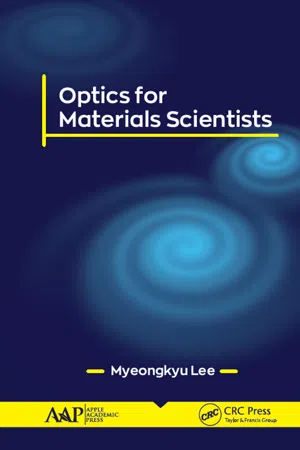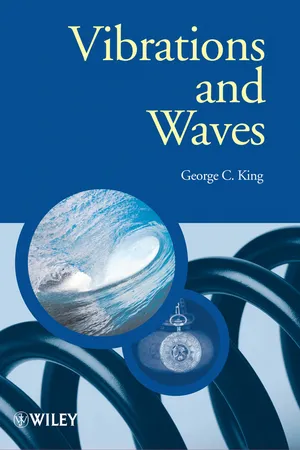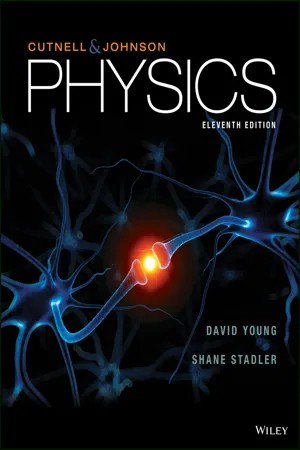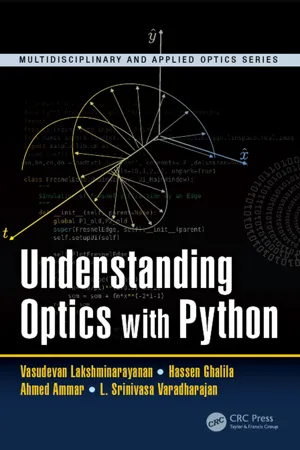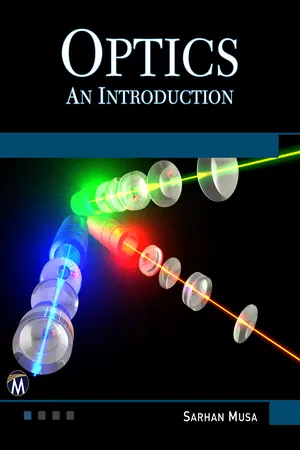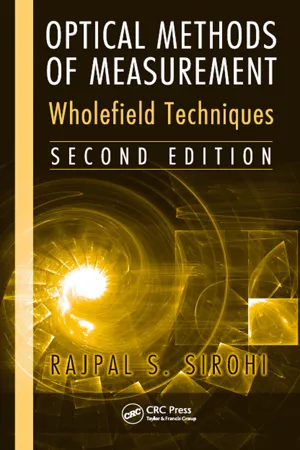Physics
Interference
Interference refers to the interaction of two or more waves, resulting in the combination of their amplitudes. In physics, interference can lead to the reinforcement or cancellation of waves, producing patterns of varying intensity. This phenomenon is commonly observed in optics, acoustics, and quantum mechanics, and plays a crucial role in understanding wave behavior.
Written by Perlego with AI-assistance
Related key terms
Related key terms
1 of 4
Related key terms
1 of 3
12 Key excerpts on "Interference"
- eBook - ePub
- Myeongkyu Lee(Author)
- 2019(Publication Date)
- Apple Academic Press(Publisher)
CHAPTER 4Interference
4.1 INTRODUCTION
Interference is a phenomenon in which two or more waves are superimposed to give a resultant intensity different from the intensity summation of the individual waves. Interference effects can be observed in all types of waves, including electromagnetic wave, acoustic wave, and matter wave, though our discussion here is limited to the Interference of light. In order for light waves to interfere, they should be correlated or coherent with one another. This requires that the waves involved in Interference come from the same source or have the same frequency. The principle of Interference is equal to the principle of superposition. If a crest of a wave meets a crest of another wave of the same frequency, the resultant amplitude becomes the vector sum of the individual amplitudes. Thus, the two waves must have the same polarization in order to maximize the Interference effect. When waves of different polarization are added together, they result in a wave that has a polarization state different from those of the original waves. Interference can be easily observed in our daily life. For example, the colors observed in a soap bubble arise from the Interference of light reflecting off the front and rear surfaces of the bubble film. The surfaces of many objects (butterfly wings, sea shells, and some minerals) appear to change color as the angle of illumination or the angle of observation changes. This is often created by the Interference of light with surface microstructures. A simple one-dimensional (1D) Interference pattern (or fringe) is obtained when two plane waves of the same frequency intersect at a non-zero angle. The resulting fringe consists of alternating bright (constructive Interference) and dark (destructive Interference) regions. In this case, Interference is a kind of energy redistribution process. The energy lost at the destructive Interference is regained at the constructive Interference. Interference can also occur between multiple beams, once the phase differences between them remain constant over the observation time. Interferometry refers to a family of techniques in which waves, usually electromagnetic waves, are superimposed to retrieve certain information. Interferometers are widely used for the measurements of small displacements, refractive index changes, and surface irregularities. Interferometry has made a significant contribution to the advancement of astronomy, spectroscopy, and optical/engineering metrology. Interferometers are generally classified into amplitude-splitting and wavefront-splitting systems.1 , 2 , 3 , 4 , 5 , 6 - Tamer Bécherrawy(Author)
- 2013(Publication Date)
- Wiley-ISTE(Publisher)
Chapter 8Interference and DiffractionIf two beams of particles are intercepted on the same region of a screen, the energy, momentum and other physical quantities, which are received at each point, are the sums of the corresponding quantities for the beams if they are intercepted separately. This is not the case if two waves superpose in a region of space; the experiment shows that there is a redistribution of physical quantities. We say that the waves interfere . On the other hand, a free particle has rectilinear motion even if it passes near a body or through an aperture with which it does not interact. The experiment shows that a wave deviates from its straight-line propagation if it encounters an obstacle, or it passes through an aperture whose dimensions are comparable to the wavelength. This effect is known as diffraction . Interference and diffraction are two characteristic properties of waves; they are consequences of the superposition principle of waves and the quadratic dependence of the physical quantities on u .In this chapter we study the Interference and diffraction of mechanical and electromagnetic waves. In the case of vector waves, we assume that they are either longitudinal or transverse but polarized linearly in the same direction; this allows us to replace their vector sums by algebraic sums, just like in the case of scalar waves. We will not discuss the questions that are specific to optics, such as coherence, Interference setups, effects of diffraction on the formation of images, polarization, etc.8.1. Order and fringes of Interference of two waves
Consider two waves with equal frequencies and equal amplitudes, that are emitted by two sources S 1 and S 2 at a sufficiently long distance from the region of observation, so that the amplitude of the waves varies little in this region (Figure 8.1a ). By “sources”, we mean either the emitters of the waves or two small apertures through which the waves pass before their superposition at a point M . If a wave travels a distance r in a homogeneous medium, it undergoes a phase lag ωr/v , were v is the speed of propagation. If the waves at the sources are u 1 = A cos(ωt −ϕ1 ) and u 2 = A cos(ωt − ϕ2 ), their expressions at M are u 1 = A cos[ω(t − r 1 /v ) − ϕ1 ] and u 2 = A cos[ω(t − r 2 /v ) − ϕ2 ], where r 1 and r 2 are the distances of M to the sources, measured along the wave path. The phases ϕ1 and ϕ2 of the sources may always be chosen in such a way that the amplitudes are positive. The resultant wave at M- eBook - ePub
- George C. King(Author)
- 2013(Publication Date)
- Wiley(Publisher)
7
Interference and Diffraction of Waves
Interference and diffraction are some of the most striking phenomena produced by waves. Interference is evident in the rainbow of colours produced by a thin film of oil on a wet road, where the light reflected off the surface of the oil interferes with the light reflected off the water surface underneath. Diffraction is evident when water waves are incident upon the narrow mouth of a harbour. The waves spread out in a semicircular fashion after passing through the harbour mouth. We shall begin by discussing Interference and later turn our attention to diffraction. However, there is no fundamental physical difference between Interference and diffraction; they both result from the overlap and superposition of waves.7.1 Interference AND HUYGEN’S PRINCIPLE
Suppose that we have two monochromatic waves ψ 1 and ψ 2 with wavelength λ that have been derived from the same source: this avoids any random phase changes from two separate sources. These waves follow different paths and are recombined at a particular point in space. The difference in their path lengths from the common source is s. If this path difference is equal to an integral number of wavelengths, the crests and the troughs of one wave line up exactly with the crests and the troughs of the other wave, as shown in Figure 7.1(a) : the two waves are said to be in phase . There is constructive Interference and the amplitude of the superposition (ψ 1 + ψ 2 ) is equal to 2A where A is the amplitude of the individual waves. If the path difference is an odd number of half wavelengths, the crests of one wave line up with the troughs of the other wave as shown in Figure 7.2(b) : the two waves are said to be out of phase . There is destructive Interference - eBook - ePub
- John D. Cutnell, Kenneth W. Johnson, David Young, Shane Stadler(Authors)
- 2018(Publication Date)
- Wiley(Publisher)
CHAPTER 27Interference and the Wave Nature of LightWave Interference occurs when two or more waves exist simultaneously at the same place. Light is an electromagnetic wave and, therefore, can exhibit Interference effects. The Interference of light waves is responsible for the lovely iridescent colors of the feathers on this purple-crested turaco from South Africa.LEARNING OBJECTIVES
After reading this module, you should be able to…- 27.1 Apply the principle of linear superposition to light waves.
- 27.2 Analyze double-slit Interference.
- 27.3 Analyze thin-film Interference.
- 27.4 Understand the operation of the Michelson interferometer.
- 27.5 Analyze single-slit diffraction.
- 27.6 Determine the resolving power of lenses.
- 27.7 Apply Interference principles to the diffraction grating.
- 27.8 Analyze the role of Interference in reading compact discs (CDs) and digital video discs (DVDs).
- 27.9 Describe X-ray diffraction in crystals.
27.1 The Principle of Linear Superposition
Chapter 17 examines what happens when several sound waves are present at the same place at the same time. The pressure disturbance that results is governed by the principle of linear superposition, which states that the resultant disturbance is the sum of the disturbances from the individual waves. Light is also a wave, an electromagnetic wave, and it too obeys the superposition principle. When two or more light waves pass through a given point, their electric fields combine according to the principle of linear superposition and produce a resultant electric field. According to Equation 24.5b - eBook - ePub
- Jerry Marion(Author)
- 2012(Publication Date)
- Academic Press(Publisher)
CHAPTER 11Interference Phenomena
Publisher Summary
In problems involving electromagnetic radiation, particularly in the field of optics, the Interference of waves from two or more sources is of prime importance. The emission of radiation from a real physical source of light is not continuous but takes the form of great numbers of short bursts of radiation (photons). Thus, the light source is subject to fluctuations. However, if the fluctuations in two beams of light are correlated—as they would be if they were derived from the same source—then, the Interference between the beams is possible. Such beams are said to be coherent. The correlation of the fluctuations in two light beams can be stated in terms of the phases of the waves involved. Thus, two beams are coherent if there exists a definite phase difference among the waves in the two beams. If no such definite phase relation exists—that is, if the phases are random—then, the beams are incoherent. Whereas coherent beams can interfere to produce the regular variations of intensity, such effects tend to cancel in incoherent beams and the resultant intensity is just the sum of the individual intensities. The possibility of Interference between the two beams of radiation is dependent upon the existence of a definite phase relation among the waves.11.1 Introduction
In a great many problems involving electromagnetic radiation, particularly in the field of optics, the Interference of waves from two or more sources is of prime importance. We have already encountered several examples of Interference effects: For example, in Section 6.5 , the standing wave produced when an electromagnetic wave is incident normally on a perfect conductor is a result of the Interference between the incident and reflected waves. In Section 10.4 we found that there was Interference between the incoming and outgoing waves when radiation is scattered by an object. In both of these cases, the Interference was between an incident and a reflected wave; i.e., both waves were derived ultimately from the same source. This is a crucial point, since the emission of radiation from a real physical source of light is not continuous but takes the form of great numbers of short bursts of radiation (photons ). Thus, the light source is subject to fluctuations. But if the fluctuations in two beams of light are correlated (as they would be if they were derived from the same source), then Interference between the beams is possible. Such beams are said to be coherent . The correlation of the fluctuations in two light beams can be stated in terms of the phases of the waves involved. Thus, two beams are coherent if there exists a definite phase difference between waves in the two beams. If no such definite phase relation exists (i.e., if the phases are random ), then the beams are incoherent - eBook - ePub
- Vasudevan Lakshminarayanan, Hassen Ghalila, Ahmed Ammar, L. Srinivasa Varadharajan(Authors)
- 2018(Publication Date)
- CRC Press(Publisher)
9 InterferenceThe intensity resulting from the linear superposition of waves at any point of space is not always the sum of the intensity of each wave. The resultant is sometimes a succession of bright fringes (maxima of intensity) and dark fringes (minima of intensity). This phenomenon appears when Interference occur between waves. The magnitude of this phenomenon is measured by the contrast coefficient, also called the visibility.We start this chapter by introducing generalities that allow us to establish the necessary conditions for Interference. Then we introduce the different ways to observe Interference phenomena. These are mainly divided in two parts, wavefront division and amplitude division interferometry. For both of these, the sources of light are assumed to be point sources and monochromatic. This hypothesis simplifies considerably the description of issues, e.g., the localization of the fringes. Finally, we discuss incoherent sources with spatial and spectral extension.9.1 GENERALITIESWe focus here on the interaction between two waves only in order to simply highlight the main factors that reveal the Interference. We also discuss the particular case of the beat phenomenon that we encounter when two waves with very close wavelengths propagate together. This phenomenon is easily perceptible in the acoustic field because the temporal periodicity is of the order of the millisecond. But in optics, the temporal periodicity is of the order of femtosecond, which is too short to be easily observable. However, the study of beats allows us to introduce some notions such as the phase velocity and the group velocity. In order to simplify the explanations, we consider here unidirectional propagation only.9.1.1 NECESSARY CONDITIONSThe Interference phenomenon occurs when two waves of the same frequency and same polarization and a constant phase difference simultaneously propagate in the same region of space. Let’s consider two plane waves whose expression of the electric field is given by: - eBook - ePub
- Cesar A. Sciammarella, Federico M. Sciammarella(Authors)
- 2012(Publication Date)
- Wiley(Publisher)
One very important property of polarized light is the phenomenon of Interference. This phenomenon can be expressed in the paradox, light plus light equal darkness. The superposition of two wave fronts of polarized light propagating along of the same trajectory with a difference of phase was also considered. At this point it is important to consider a more general case of superposition. For example, two wave fronts interacting with each other but following different paths generating a phenomenon called Interference. From this wave front interaction regions are created where the resulting electromagnetic field is null and other regions where the electromagnetic field is maximum. This is known as the creation of Interference fringes.Interference fringes from the point of view of light as a particle, a photon, indicate that in some region of space the probability of finding a photon is very low near zero (dark regions) or very high near one (bright regions). Recent experiments show that this phenomenon can be observed even if one introduces only one photon at a time in the field of observation. In order to observe the Interference phenomenon the propagating fields must be in closely related states of polarization. Recall that superposition implies summing of the vectors. For example, two plane polarized beams polarized in orthogonal directions do not produce Interference fringes. They simply combine in the forms that were seen when analyzing polarized light. The concept of coherence that covers different aspects of the interaction of polarized light must be introduced. When interfering, two wave fronts can add together to create a field of larger amplitude (constructive Interference) or subtract from each other to create a smaller amplitude field wave (destructive Interference), depending on their relative phase. Two waves are said to be coherent if they interfere. The degree of coherence is measured by the Interference visibility, a measure of how perfectly the waves can cancel due to destructive Interference. The concept of visibility of interfering fringes will be well defined later on. - eBook - ePub
Optics
An Introduction
- Sarhan M. Musa(Author)
- 2020(Publication Date)
- Mercury Learning and Information(Publisher)
CHAPTER 9Interference OF LIGHTChapter Outline9.0Introduction9.1Principle of Superposition9.2Discovery of Interference of Light9.3Theory of Interference9.4Conditions for Interference9.5Classification of Interference Phenomena9.6Fresnel’s Experimental Arrangements9.7Interference with White Light9.8Displacement of the Fringes9.9Lloyd’s Single Mirror9.10Achromatic Interference Fringes9.11Billet Split Lens9.12Production of Circular Interference Fringes—Meslin’s Split Lens9.13Exercises9.0 INTRODUCTIONIt is a matter of common experience that two trains of ripples on the surface of water cross each other and proceed onward in their directions undisturbed. In the same way, two beams of light cross each other and proceed without being influenced by each other in any way. For example, different observers can view at the same instant different objects through the same narrow aperture with perfect clarity, the beams of light having crossed at the aperture in reaching the observers. However, in the region of crossing where both the beams are acting simultaneously, a modification in their intensity is expected, which should be either less or greater than that which would be given by one beam alone. This modification of intensity due to superposition of two or more beams of light is spoken of as Interference of light. This phenomenon demands for its explanation that light must be a wave motion.9.1 PRINCIPLE OF SUPERPOSITIONThe fundamental basis of the explanation of the phenomenon of Interference of light is the principle of superposition of wave motions first enunciated by Thomas Young in 1801. This principle states that when a medium is disturbed simultaneously by any number of waves, the instantaneous resultant displacement of the medium at every point at every instant is the algebraic sum of the displacements of the medium due to individual waves, in the absence of the others. In Young’s own words: “When two undulations from different origins coincide, either perfectly or very nearly, in direction, their joint effect is a combination of the motions belonging to each.” Suppose due to a single wave train the displacement of the medium at a certain point at any instant is y1 in a given direction and that due to another wave train, in the absence of the first, the displacement is y2 . According to the previous principle, the instantaneous resultant displacement R - eBook - ePub
- Anupam Garg(Author)
- 2012(Publication Date)
- Princeton University Press(Publisher)
8 Interference phenomenaWe turn in this chapter to optical phenomena where the intensity of the light field changes rapidly, either in space or in time, due to the superposition of two or more waves with well-defined phase relationships. Historically, these phenomena, particularly the observation that orthogonal polarizations did not interfere, played a crucial role in elucidating the nature of light as a transverse wave. Their study is a vast and continuing area of research, and our treatment is necessarily cursory. However, we also discuss some twentieth-century developments in this area, such as the description of partially polarized light in terms of correlation functions, the Hanbury-Brown and Twiss effect, and the Pancharatnam phase.48 Interference and diffraction
We saw in section 44 that a beam that is focused down to a spot of diameter ω 0 diverges with an angular half-width Δθ λ/2πω 0 . This is a general consequence of the finiteness of the wavelength. Suppose that at a distance z along the beam, it has a finite extent Δx and Δy in the transverse directions. The field can be represented aswhere k 0 is the mean wave vector. Because of the finite transverse extent, the Fourier amplitudes E k will be spread out over widths Δk x , Δk y , whereTaking the minimum spread in real space for Δx and Δy , we get Δk x,y ~ w 0 −1 . Thus, the angular width isFIGURE 8.1. (a) Basic diffraction setup. (b) Definitions of various vectors and integration surfaces used in deriving the integral equation for the diffracted field. The surface S 1 consists of the entire xy plane, screen plus aperture.Phenomena such as the above, which may be regarded as corrections to geometrical optics because of the nonzero wavelength of light, go under the names of Interference and diffraction. These terms are sometimes more narrowly used to describe effects that arise when light falls on obstacles whose dimensions are much greater than the wavelength of the light.1 The prototypical phenomenon is the existence of a nonzero intensity in the geometrical shadow. Suppose that a plane EM wave falls on an aperture in a flat screen, which we take to lie in the xy plane (see fig. 8.1 ). The linear dimensions of the aperture are denoted by a . What is the field beyond the aperture, in the region z > 0? A heuristic answer is given by Huygens’s principle. This states that each point of a wave front acts as a source of secondary spherical wavelets. Thus, if r ′ is a point in the aperture, and the incident field there is ψ inc (r′) , it produces a spherical wave, whose contribution to the field at a point r is proportional toeik|r−r′|/|r−r′| . The total field at r - eBook - ePub
- Francesco Simoni(Author)
- 2018(Publication Date)
- WSPC(Publisher)
Section 1.7 ).In the visible it gives rise to a pattern of dark and bright fringes. An example of such a pattern is given in Fig. 1.9 , where a picture of the Interference of two waves coming from vertical apertures is shown.In the case where the phase difference is due only to a different path d traveled by the two waves, with the corresponding phase difference5 ϕ = k0 nd = (2π/λ0 )nd and defining the optical path as δ = nd, the conditions (1.135) and (1.136) becomeThese are the most-used relationships to figure out when one gets constructive Interference (optical path difference integer multiple of wavelength) or destructive Interference (optical path difference odd multiple of half wavelength).The two cases are depicted in Fig. 1.10 , where the fields of two waves of equal amplitude are plotted versus time. In the first case the condition (1.138) is fulfilled, while in the second case the condition (1.139) is fulfilled.The corresponding intensity distribution versus the optical path difference is shown in Fig. 1.11 .Fig. 1.10. Superposition of equal amplitude waves with the same phase (a) and with opposite phases (b).Fig. 1.11. Intensity distribution versus optical path difference for two interfering waves of equal intensity I0 . Here λ0 is the wavelength in vacuum.Usually the contrast of the Interference pattern is measured by the fringe visibility, defined aswhich falls in the range between 0 (Imax = Imin ; no fringes) and 1 (Imin = 0; maximum visibility of the fringes). The latter condition can be realized in the case of equal intensities (I1 = I2 ≡ I0 - eBook - ePub
Optical Methods of Measurement
Wholefield Techniques, Second Edition
- Rajpal Sirohi(Author)
- 2018(Publication Date)
- CRC Press(Publisher)
2 Optical Interference 2.1 INTRODUCTION Light waves are electromagnetic waves. They can be spherical, cylindrical, or plane, as has been explained in Chapter 1. By modulating wave properties such as amplitude, phase, and polarization, it is possible for light waves to carry information. In a homogenous, isotropic medium, there is usually no interaction between the wave and the medium. However, at very high intensities, some nonlinear effects begin to come into play. Our interest for now is to study the superposition of two or more waves. If the waves are traveling in the same direction, they will have a very large region of superposition. In contrast, if the angle between their directions of propagation is large, the region of superposition will be small. As the angle between the two waves increases, the region of superposition continues to decrease, and reaches a minimum when they propagate at right angles to each other. As the angle is further increased, the region of superposition also increases, reaching a maximum when they are antipropagating. Let us consider the superposition of two coherent monochromatic waves. The amplitude distribution of these waves can be written as follows: E 1 (x, y, z ; t) = E 01 (x, y, z) exp [ i (ω t + k 1 ⋅ r + δ 1) ] (2.1) E 2 (x, y, z ; t) = E 02 (x, y, z) exp [ i (ω t + k 2 ⋅ r + δ 2) ] (2.2) The total amplitude is the sum of the. amplitudes of the individual waves. This can be expressed as follows: E (x, y, z ; t) = E 1 (x, y, z ; t) + E 2 (x, y, z ; t) (2.3) The intensity distribution at a point (x, y, z) can be obtained as. follows: I (x, y, z) = 〈 E (x, y, z ; t) ⋅ E (x, y, z) 〉 = E 01 2 + E 02 2 + 2 E 01 ⋅ E 02 cos [ (k 2 − k 1) ⋅ r + ϕ ] (2.4) Here (k 2 – k 1) · r + ϕ is the phase difference between the waves and ϕ = δ 2 – δ 1 is the initial phase difference, which can be set equal to zero. It is seen that the intensity at a point depends on the phase difference between the waves - eBook - ePub
- Lazo M. Manojlovi?(Author)
- 2022(Publication Date)
- Apple Academic Press(Publisher)
CHAPTER 4 Coherence and Interference of LightABSTRACT
Finite size of the spectral bandwidth of a light source requires more powerful theory to process the optical phenomena accompanying such sources. The coherence theory, which is basically a statistical theory that describes the properties of the radiation field in terms of the correlation between the vibrations at different points in the field, offers the possibility to describe such phenomena. The waves originating from different points of a finite-size light source or even from the same point of a thermal source, exhibit random amplitude and phase fluctuations. If such wave fields illuminate, two points in space or the same point at different instants of time exhibit only partial correlation.4.1 TWO-BEAM Interference
A light ray, which concept was used in describing the geometrical optics phenomena, fails trying to explain optical phenomena like diffraction and Interference. Therefore, instead of a light ray, the wave nature of electromagnetic radiation will be taken into consideration in this chapter. For the purpose of simplicity, we will consider only a linearly polarized plane wave propagating in a vacuum in the z-axis direction. In this case, the electric field at any point along the direction of propagation and any time moment can be represented by a harmonic function of distance and time as:E(4.1)(=z , t)E 0cos(,ω t − k z)where E0 is the electrical field amplitude, k is the wavenumber, and ω is the angular frequency. Sometimes, it is more convenient to represent an electrical field of a plane wave by using Euler representation of complex number as:E(4.2)(= Rez , t){,}E 0exp[j](ω t − k z)where Re{•} represents the real part of a complex number. If the mathematical operations on electrical field are linear, then, without losing the meaning of the analysis, we can represent the electrical field as a complex number in the following form:
Index pages curate the most relevant extracts from our library of academic textbooks. They’ve been created using an in-house natural language model (NLM), each adding context and meaning to key research topics.
Explore more topic indexes
Explore more topic indexes
1 of 6
Explore more topic indexes
1 of 4
